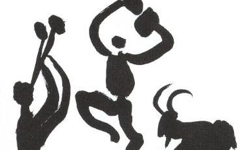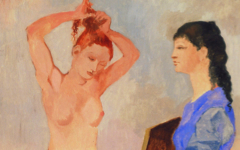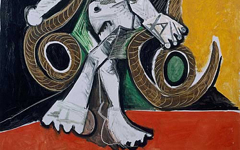Picasso’s Bullfight Scene (1955)
In this Bullfight Scene painted by Picasso in 1955 the sword that kills the bull is spotlit in the center. If specialists knew that swords in art are often symbols for a paintbrush, they might have also recognized that Picasso’s sword-paintbrush forms the “P” of his own name.
Click next thumbnail to continue
Indeed, in a further pun, the sword also resembles the Chi Ro cross, suggesting to those who can read art, that Picasso is Christ as well. The Chi Ro (left) is the ancient symbol of Christ.
Click next thumbnail to continue
In the foreground the bull's legs form an “M”, a common reference in Picasso's work to Edouard Manet, whose own bullfight scenes seem to have opened Picasso’s eyes to other methods. Manet himself made constant use of M-forms.1 Picasso’s obsession with Manet’s name and initial can be seen in a very large number of his works.2
Click next thumbnail to continue
Conventional belief holds that the spectator is on this side of the canvas trying to make sense of the scene. Yet Picasso puts the spectators on the other side looking back at the art because the only valid perspective from this side of the canvas, inside the artist's mind, is the artist’s.
In art, death has also long been linked with the completion of a painting which is why Picasso’s sword “signs” the painting at the very moment the bull dies.
More Works by Picasso
Learn how Picasso bases an image on the letters of his signature

Picasso’s Musician, Dancer, Goat and Bird (1959)
Notes:
1. Manet used M-forms in the legs of the seated figures in Le Déjeuner sur l'Herbe, behind the matador in Mlle V in the Costume of an Espada, in Croquet at Boulogne, in Café-Concert and Monet Painting on his Studio-Boat among many others.
2. In later life Picasso painted and drew many variations on Manet's Le Déjeuner sur l'Herbe. It has never been noted, though, that Manet included a similar M-shape in Le Déjeuner (formed from the legs of the reclining figures) to indicate his own self-representation. Picasso, however, included Manet's name and initials elsewhere as well as will be shown on this site shortly.
Original Publication Date on EPPH: 06 Sep 2010. | Updated: 0. © Simon Abrahams. Articles on this site are the copyright of Simon Abrahams. To use copyrighted material in print or other media for purposes beyond 'fair use', you must obtain permission from the copyright owner. Websites may link to this page without permission (please do) but may not reproduce the material on their own site without crediting Simon Abrahams and EPPH.






